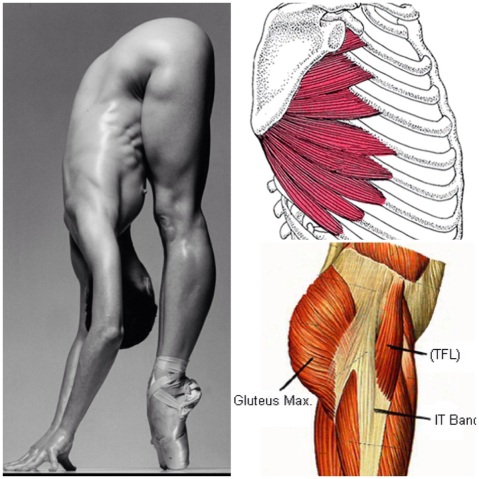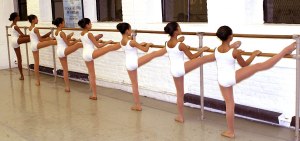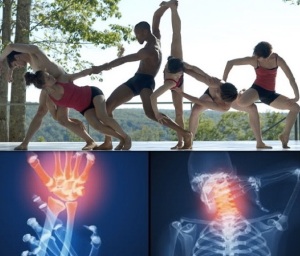Stretching for Young or New Dancers
Question from a ‘ST 4 Dancers’ follower about stretching for young dancers:
“In your opinion what sort of stretches are best for young dancers with relatively good flexibility? What sort of time frame should they be held for? And what is your view of young dancers being told to ‘suck it up’ and held in a stretch even though it clearly hurts to the point of tears?
Thank you for your time!”
Sports Therapy 4 Dancers reply:
When stretching, you’re working with the nervous system as well as the muscle fibres. It’s the nervous system – specifically the muscles spindles – that holds the muscles at a certain level of tension and allows them to stretch. If you push the body to the point of extreme pain, it rebels eventually as a protective mechanism! In order to achieve certain goals, you may have to be ‘tough’ on young dancers, but holding a less intense stretch for longer will, in my opinion, be more effective at lengthening the muscle fibres and improving flexibility.
As far as which stretches to do? I could, and will, write a whole separate blog on this! Most dancers are keen to be able to kick their head (!) so really go for it when stretching the back of the legs, but often forget to target the muscles and fascia in the front. I’ve seen lots of knee problems occur because quadriceps and hip flexors (in the front) are completely out of balance with the hamstrings (in the back), so don’t forget to include lunges (for hips) and quad stretches (for knees). Ones to avoid might be those that put extra strain on joints as opposed to muscles i.e. sitting in second position and lying forward with the chest on the floor – especially if the feet are allowed to roll in. I would also recommend not flexing the feet when on the floor in a deep parallel forward stretch as this just irritates the nerve at the back of the leg and can sometimes lead to increased contraction in the muscles you’re trying to lengthen, as the body attempts to protect itself.
Length of time to hold should be at least 30 seconds, repeated if possible. Ideally (as with other forms of therapeutic soft tissue work), the stretch should feel easier and less painful after holding it, rather than vice versa. You may have heard of both static and dynamic stretches. As the name suggests, a static stretch is held in one position while the rest of the body is relatively still, for example when you stand with one foot behind the other, shoulder width apart, bend the front leg and stretch the calf muscles in the back leg. Actively moving through positions, (but not bouncing) is the best way to think of dynamic stretching. For example doing an unplaced cloche at the barre, where the leg swings forwards and backwards, serving to loosen the hip joint and stretch the leg muscles. There are various explanations and reasonings for when to include each version, but I would suggest that dynamic stretches be used after a comprehensive warm-up (article on its way), before class or rehearsal, to prepare the body in a manner that does not potentially compromise power (for elevation etc). Static stretches are most effective for improving long-term flexibility and should be performed at the end of a class when the dancer is hot and tired.
I hope this helps clarify a few points. The body is a wonder at adapting to what we ask it to do, but forcing anything usually results in injuries! Time, dedication and a bit of education goes a long way.
Photo from Dance Theatre of Harlem.
Anatomy in Motion

This is a gorgeous photo, but I particularly like it because you can so clearly see certain muscles in her lean body. Namely the Serratus Anterior, which attaches from the ribs to the shoulder blade, and the tensor fasciae latae (TFL), a hip flexor, which attaches from the top of the pelvis, into the notorious Ilio-tibial band at the side of the thigh. You can see it here as the little ball-like shape at the crease of her hip.
No credit for the photographer or dancer I’m afraid, so if anyone has any information, please share. Anatomical images borrowed from the web… enjoy!
ITB Syndrome? Stretch those glutes and hip flexors!

Ilio-Tibial Band Syndrome affects the outside of the thigh – usually around the hip or closer to the knee, where this large tendon-like structure can rub against the outside of the heads of the femur. Under normal circumstances, this movement over the bones happens without consequence, but through over-training, weakness in muscles (particularly the glutes) or bad alignment, excess friction can lead to inflammation and pain. Treatment should proceed with rest and ice for 3-5 days. It is widely accepted that foam rolling or ‘manual stripping’ (by a therapist) of the ITB helps to improve blood supply and flexibility to the area, thus improving symptoms. Roll from the bottom – up (knee to hip). However, because the ITB is meant to stabilise the knee and hip, it’s not designed to stretch! In my opinion, increasing flexibility in the muscles that attach to it (glutes and hip flexors) is far more beneficial. Dancers often find the usual stretches don’t target the area sufficiently. I use the stretches in the photo (starting with a raised back, then leaning forward to rest the chest on the leg and eventually adding the twist and holding the toe). Make sure you check your technique and don’t over-train!
Noisy Joints?
“Why do my joints crack and why does it feel so good” is a question that I’m asked quite often, so here is the answer:
Your joints crack for 3 main reasons:
1 – Gas dispersing in the joint capsule
2 – Tendons or ligaments moving over other soft tissues/bone
3 – Crepitus due to wear and tear of cartilage
The first is usually the most common reason. Synovial (the most mobile) joints, are encased in thick synovial fluid within the joint capsule. When the bones in the joint are taken to their maximum range under pressure (e.g. lacing the fingers and pushing the palms away from you), the whole unit is stretched, which increases its volume, thereby decreasing the pressure inside the joint. This allows gases within the fluid to disperse. This process is called ‘Cavitation’ and explains the audible ‘pop’ that you hear when joints are manipulated. It usually takes 30 minutes to a few hours for the gas to build up, which is why you often have to wait a while before you can crack the joint again. If a joint does pop or crack repeatedly, it may be a sign that the sound is coming from a tendon or ligament.
The reason people often feel a release after cracking a joint is that the ‘Golgi Tendon Organ’ (which senses and monitors the amount of tension in soft tissues) is stimulated and sends a signal to relax the surrounding muscles.
The good news is that there isn’t any hard evidence that repeatedly cracking joints, be it a back, ankle, knee, knuckle, hip or neck, will cause arthritis. However, it can certainly lead to overstretched ligaments, which may cause weakness and potential pain.
Flexibility vs Stability
Is flexibility AND stability a reality? In order to have good stability, you generally have to sacrifice flexibility and vice versa. This is a conundrum that many dancers face. We all want to be able to kick our head in a battement or brush the ground with our hair in a back bend, but at what cost? Dancers who have this kind of wonderful pliability, often suffer from certain kinds of injuries due to the nature of their soft tissues. Supple muscles, tendons and ligaments mean dancers are more prone to dislocations and serious sprains. On the other hand, dancers who battle with limited flexibility can sustain injuries such as hamstring strains and tendinosis (degeneration of the tendon that attaches the muscle to the bone). Of course neither group’s injuries are exclusive, but it is a reality that all dancers must face; flexibility AND stability are a rare and greatly sought after combination.
Naturally flexible dancers should work on their strength and proprioception (the position of their body and its parts in space). Less flexible dancers should stretch continually, but at a comfortable level. Always remember that you’re working with your nervous system and have to allow it to accept the desired length of muscle fibres. If it hurts, your body will think it’s in danger and contract the tissues further!
Images from ‘Dance first, think later’ on Tumblr
Image of female dancer: Ronnie Boehm Dance Photography



Recent Comments